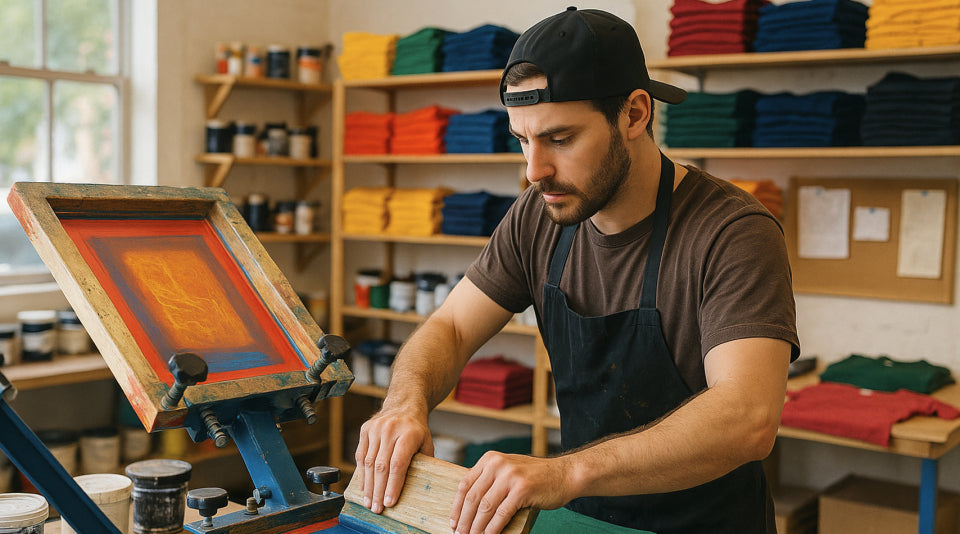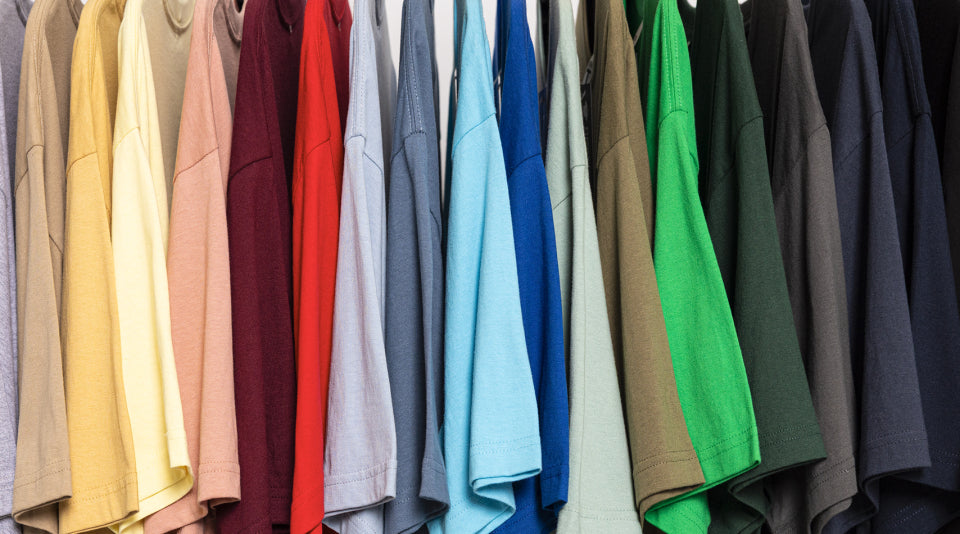DTF printing, or Direct to Film printing, is a method for creating high-quality designs on fabrics.
It’s different from traditional methods like screen printing and DTG, offering more flexibility and better quality. In this guide, you’ll discover what makes DTF printing special, how it works, and its pros and cons.
Key Takeaways
- DTF printing offers versatility by allowing high-quality designs on a diverse range of fabrics, including cotton, polyester, and leather.
- While DTF printing is cost-effective for small quantities, it requires specialized equipment and managing hot melt adhesive powder can be a challenge.
- Choosing the right DTF printer involves considering resolution, print speed, and ease of use, with regular maintenance being crucial for optimal performance.
Understanding DTF Printing
DTF printing, or Direct to Film printing, is a cutting-edge transfer process that utilizes heat-press technology and advanced printing technology to create high-quality designs on various fabrics. Unlike traditional printing methods like Direct to Garment (DTG) or screen printing, direct to film dtf printing offers unmatched versatility, allowing you to print on materials such as cotton, polyester, synthetic fabrics, and even silk.
One of the standout features of DTF printers is their ability to work effectively on both light and dark fabrics, providing endless design possibilities. This flexibility makes DTF printing an excellent choice for businesses looking to offer custom apparel, as it ensures flawless final designs that maintain high quality in print.
Moreover, the DTF process is not just limited to cotton fabrics and poly blends. Its ability to adapt to various substrates, including unconventional materials, sets it apart from other printing methods. Whether you’re printing on a t-shirt, a hoodie, or even a piece of leather, DTF printing guarantees vibrant, detailed results.
How Does the DTF Process Work?
The DTF process begins with creating a design using specialized DTF software. Once your design is ready, it is printed onto a special transfer film using DTF printers equipped with specialized inks. This initial step is crucial as it sets the foundation for the entire dtf transfer printing process.
After printing the design on the DTF film, a thin layer of curing powder is applied to the printed design. This powder acts as an adhesive that will later bond the design to the fabric. The next step involves heating the curing powder using a heat press or a curing oven to ensure it melts and adheres effectively to the fabric.
Once the design has been heat-pressed onto the fabric, the final step is to peel away the transfer film, revealing the printed design embedded in the fabric. This heat press machine transfer method ensures the design is durable and vibrant, bringing your creations to life with impeccable quality.
Key Components of DTF Printers
DTF printers are equipped with several key components that make this printing method unique. One of the most critical elements is the specialized pigmented dtf ink tailored specifically for DTF printing. These inks ensure that the colors are vibrant and durable, providing high-quality prints every time.
PET films are another crucial component in the DTF process. These films can be obtained as cut sheets for smaller applications or rolls for larger commercial needs. The use of a single film print simplifies the setup for multi-color designs, making it more efficient than screen printing, which requires separate stencils for each color.
Additionally, specialized RIP software plays a crucial role in managing color accuracy and optimizing print quality. This software ensures that the final output is sharp, vibrant, and true to the original design, making it an indispensable part of the DTF printing process.
Advantages of DTF Printing
DTF printing produces vibrant, detailed designs on various fabrics, not just cotton. This versatility allows businesses to offer a wide range of custom apparel, from t-shirts to hoodies, without compromising on quality or color vibrancy.
DTF printing is also cost-effective, particularly for smaller quantities. The production costs associated with DTF printing are significantly lower compared to other printing methods, such as screen printing. This affordability makes it an attractive option for startups and small businesses looking to enter the custom apparel market.
Additionally, DTF printing works effectively on both light and dark garments, adding to its versatility. Whether you’re printing on a white cotton t-shirt or a black polyester hoodie, DTF ensures high-quality prints with consistent color vibrancy and durability.
Challenges in DTF Printing
Despite its numerous advantages, DTF printing does present some challenges. Managing the hot melt adhesive powder used in the adhesion process is a primary issue. Dealing with excess powder can be messy and requires careful handling to ensure the final print quality is not compromised.
Additionally, convection ovens are necessary for drying the adhesive powder after it is applied to the printed film. This adds another layer of complexity to the process, as managing the equipment and ensuring proper curing can be challenging. Regular maintenance of DTF printers is essential to avoid clogs and other issues that can affect print quality.
The initial investment costs for acquiring DTF printing equipment and materials can be significant. While the ongoing production costs are relatively low, the upfront costs can be a barrier for startups and small businesses.
Comparing DTF Printing with Other Methods
When comparing DTF printing with other methods like screen printing, several advantages stand out. Unlike screen printing, DTF does not require separate layers for different colors or design elements, simplifying the setup and reducing production time. This makes DTF an ideal choice for intricate, multi-color designs.
DTF printing is also known for producing vibrant and durable colors, especially on darker fabrics. This quality is often superior to other printing methods, which may struggle to achieve the same level of color vibrancy and detail on dark garments. However, it’s worth noting that the speed of DTF printing can be lower compared to other methods, which may impact the ability to fulfill large or urgent orders efficiently.
Overall, DTF printing offers a unique combination of quality, versatility, and ease of use that sets it apart from traditional printing methods. Its ability to produce high-resolution designs on a wide range of substrates makes it a valuable tool for businesses in the custom apparel industry.
Choosing the Right DTF Printer for Your Business
Selecting the right DTF printer for your business is crucial to ensure successful operations and high-quality outputs. One of the key factors to consider is the resolution of the printer. A DTF printer should ideally operate at a resolution of at least 1440 DPI to ensure the output is sharp and vibrant.
Print speed is another important consideration, especially for businesses that require quick turnaround times during peak seasons. Choosing a printer with efficient print speed can help meet customer demands without compromising on quality. Additionally, ease of use is vital for first-time DTF printer users. Look for models with straightforward setup and user-friendly software to minimize the learning curve.
Cost considerations are also essential when selecting a DTF printer. While the initial equipment costs and the need for ongoing replacement parts can be significant barriers for startups, investing in a high-quality printer can pay off in the long run by ensuring consistent, high-quality prints and reducing maintenance issues.
Customer Success Stories
DTF printing has proven to be a valuable asset for many businesses, helping them enhance their operations and achieve greater customer satisfaction. Crossfit Supremacy, for example, has integrated in-house printing to produce custom products for its gym members, enhancing personalization.
Somerset College has utilized DTF printing to enhance student creativity and project development through digital print solutions. This innovative approach has allowed students to bring their ideas to life with high-quality, detailed prints.
The T-shirt Mill is another success story, having evolved from local market sales to becoming a leading player in the custom t-shirt printing industry. These customer success stories illustrate the potential of DTF printing to transform businesses and create new opportunities in the market.
Embracing DTF Printing: Key Takeaways
In summary, DTF printing offers a revolutionary approach to custom apparel production, combining versatility, high-quality prints, and cost-effectiveness. While there are challenges associated with the process, such as managing adhesive powder and initial equipment costs, the benefits far outweigh the drawbacks.
DTF printing stands out for its ability to produce vibrant, detailed designs on a wide range of fabrics, making it a valuable tool for businesses looking to offer custom apparel. By choosing the right DTF printer and following proper maintenance practices, you can ensure successful operations and high-quality outputs.
As you consider incorporating DTF printing into your business, remember the inspiring success stories of those who have already reaped the benefits of this innovative technology. Embrace the possibilities and take your custom apparel business to new heights with DTF printing.
Frequently Asked Questions
What materials can I print on using DTF printers?
DTF printers can print on a range of materials, including cotton, polyester, synthetic fabrics, and silk, offering you diverse design possibilities. This versatility makes DTF printing an excellent choice for various projects.
How does the DTF process work?
The DTF process works by printing a design onto transfer film, applying curing powder, and then using heat to transfer the design onto fabric. This method ensures vibrant, durable prints on a variety of textiles.
What are the key components of a DTF printer?
The key components of a DTF printer are specialized pigmented inks, PET films, and RIP software, which together ensure color accuracy and high print quality. Understanding these elements is essential for achieving the best results in your printing projects.
What are the advantages of DTF printing compared to other methods?
DTF printing is advantageous due to its ability to produce vibrant, detailed designs on various fabrics and cost-effectiveness for small quantities, making it more versatile for both light and dark garments compared to other methods.
What maintenance is required for DTF printers?
To ensure optimal performance of DTF printers, it's essential to perform daily printhead cleaning, conduct nozzle checks, inspect and replace worn components, and store inks and films correctly. Regular maintenance will significantly improve print quality and longevity of the equipment.






Leave a comment
All comments are moderated before being published.
This site is protected by hCaptcha and the hCaptcha Privacy Policy and Terms of Service apply.